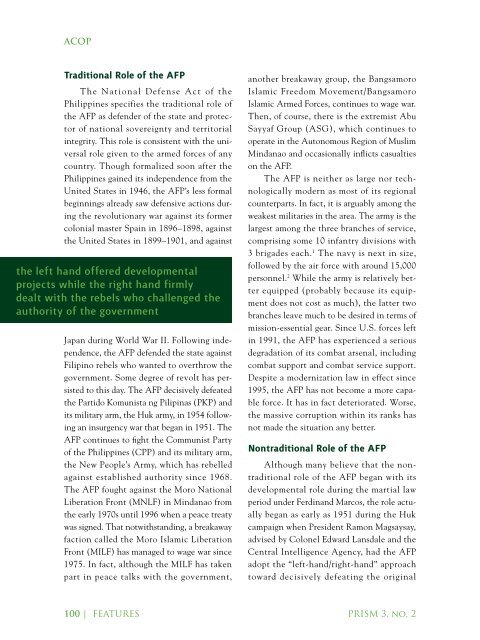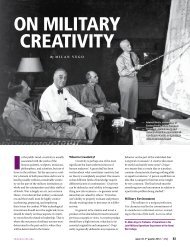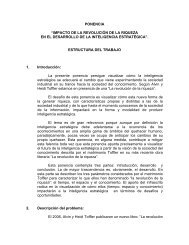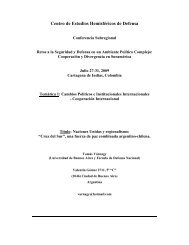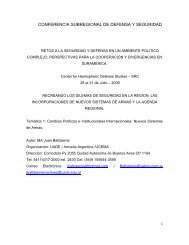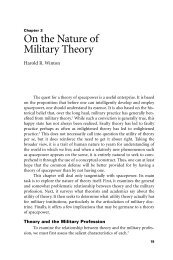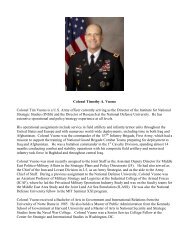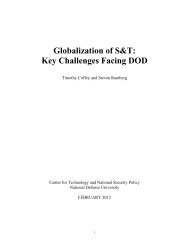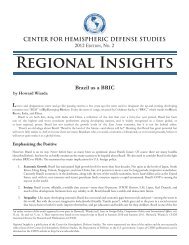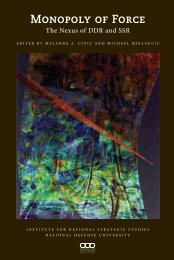The Expanded Nontraditional Role of the AFP - National Defense ...
The Expanded Nontraditional Role of the AFP - National Defense ...
The Expanded Nontraditional Role of the AFP - National Defense ...
Create successful ePaper yourself
Turn your PDF publications into a flip-book with our unique Google optimized e-Paper software.
acoP<br />
Traditional <strong>Role</strong> <strong>of</strong> <strong>the</strong> <strong>AFP</strong><br />
<strong>The</strong> <strong>National</strong> <strong>Defense</strong> Act <strong>of</strong> <strong>the</strong><br />
Philippines specifies <strong>the</strong> traditional role <strong>of</strong><br />
<strong>the</strong> <strong>AFP</strong> as defender <strong>of</strong> <strong>the</strong> state and protector<br />
<strong>of</strong> national sovereignty and territorial<br />
integrity. This role is consistent with <strong>the</strong> universal<br />
role given to <strong>the</strong> armed forces <strong>of</strong> any<br />
country. Though formalized soon after <strong>the</strong><br />
Philippines gained its independence from <strong>the</strong><br />
United States in 1946, <strong>the</strong> <strong>AFP</strong>’s less formal<br />
beginnings already saw defensive actions during<br />
<strong>the</strong> revolutionary war against its former<br />
colonial master Spain in 1896–1898, against<br />
<strong>the</strong> United States in 1899–1901, and against<br />
<strong>the</strong> left hand <strong>of</strong>fered developmental<br />
projects while <strong>the</strong> right hand firmly<br />
dealt with <strong>the</strong> rebels who challenged <strong>the</strong><br />
authority <strong>of</strong> <strong>the</strong> government<br />
Japan during World War II. Following independence,<br />
<strong>the</strong> <strong>AFP</strong> defended <strong>the</strong> state against<br />
Filipino rebels who wanted to overthrow <strong>the</strong><br />
government. Some degree <strong>of</strong> revolt has persisted<br />
to this day. <strong>The</strong> <strong>AFP</strong> decisively defeated<br />
<strong>the</strong> Partido Komunista ng Pilipinas (PKP) and<br />
its military arm, <strong>the</strong> Huk army, in 1954 following<br />
an insurgency war that began in 1951. <strong>The</strong><br />
<strong>AFP</strong> continues to fight <strong>the</strong> Communist Party<br />
<strong>of</strong> <strong>the</strong> Philippines (CPP) and its military arm,<br />
<strong>the</strong> New People’s Army, which has rebelled<br />
against established authority since 1968.<br />
<strong>The</strong> <strong>AFP</strong> fought against <strong>the</strong> Moro <strong>National</strong><br />
Liberation Front (MNLF) in Mindanao from<br />
<strong>the</strong> early 1970s until 1996 when a peace treaty<br />
was signed. That notwithstanding, a breakaway<br />
faction called <strong>the</strong> Moro Islamic Liberation<br />
Front (MILF) has managed to wage war since<br />
1975. In fact, although <strong>the</strong> MILF has taken<br />
part in peace talks with <strong>the</strong> government,<br />
ano<strong>the</strong>r breakaway group, <strong>the</strong> Bangsamoro<br />
Islamic Freedom Movement/Bangsamoro<br />
Islamic Armed Forces, continues to wage war.<br />
<strong>The</strong>n, <strong>of</strong> course, <strong>the</strong>re is <strong>the</strong> extremist Abu<br />
Sayyaf Group (ASG), which continues to<br />
operate in <strong>the</strong> Autonomous Region <strong>of</strong> Muslim<br />
Mindanao and occasionally inflicts casualties<br />
on <strong>the</strong> <strong>AFP</strong>.<br />
<strong>The</strong> <strong>AFP</strong> is nei<strong>the</strong>r as large nor technologically<br />
modern as most <strong>of</strong> its regional<br />
counterparts. In fact, it is arguably among <strong>the</strong><br />
weakest militaries in <strong>the</strong> area. <strong>The</strong> army is <strong>the</strong><br />
largest among <strong>the</strong> three branches <strong>of</strong> service,<br />
comprising some 10 infantry divisions with<br />
3 brigades each. 1 <strong>The</strong> navy is next in size,<br />
followed by <strong>the</strong> air force with around 15,000<br />
personnel. 2 While <strong>the</strong> army is relatively better<br />
equipped (probably because its equipment<br />
does not cost as much), <strong>the</strong> latter two<br />
branches leave much to be desired in terms <strong>of</strong><br />
mission-essential gear. Since U.S. forces left<br />
in 1991, <strong>the</strong> <strong>AFP</strong> has experienced a serious<br />
degradation <strong>of</strong> its combat arsenal, including<br />
combat support and combat service support.<br />
Despite a modernization law in effect since<br />
1995, <strong>the</strong> <strong>AFP</strong> has not become a more capable<br />
force. It has in fact deteriorated. Worse,<br />
<strong>the</strong> massive corruption within its ranks has<br />
not made <strong>the</strong> situation any better.<br />
<strong>Nontraditional</strong> <strong>Role</strong> <strong>of</strong> <strong>the</strong> <strong>AFP</strong><br />
Although many believe that <strong>the</strong> nontraditional<br />
role <strong>of</strong> <strong>the</strong> <strong>AFP</strong> began with its<br />
developmental role during <strong>the</strong> martial law<br />
period under Ferdinand Marcos, <strong>the</strong> role actually<br />
began as early as 1951 during <strong>the</strong> Huk<br />
campaign when President Ramon Magsaysay,<br />
advised by Colonel Edward Lansdale and <strong>the</strong><br />
Central Intelligence Agency, had <strong>the</strong> <strong>AFP</strong><br />
adopt <strong>the</strong> “left-hand/right-hand” approach<br />
toward decisively defeating <strong>the</strong> original<br />
100 | FeatuReS PRISM 3, no. 2


